
"Ossobuco alla milanese (in English, often spelled 'osso buco', or as 'osso bucco' with two c's, noted by Merriam-Webster as an alternate spelling) is a dish from Milan, capital of Lombardy, of braised veal shanks. It is usually sprinkled with gremolata, a mix of parsley, garlic and lemon peel, and served with risotto alla milanese, a risotto enhanced with heavy cream and parmesean cheese, often flavored with saffron.
The shank is cut across the bone into slices about 3cm thick, browned, and braised in white wine and aromatics.
Traditionally, ossobuco is made without tomatoes (these being unknown in Milan until the late 19th century). However, the traditional version, prepared with cinnamon, allspice, bay leaf and gremolata called in bianco, has by and large been replaced with the newer version which includes tomatoes, carrots, celery and onion, flavoured with a bouquet garni and without gremolata (although 'hybrid' versions exist which include both tomato and gremolata).
The shank is called in Italian osso buco (from Western Lombard oss bus classical orthography, òs büüs alternative orthography), lit. 'hole bone' (osso 'bone', buco 'hole'), because the bone marrow is part of the appeal of the dish."
Ossobuco, http://en.wikipedia.org/w/index.php?title=Ossobuco&oldid=202879178 (last visited Apr. 9, 2008).
In my recipe I don't bother with the gremolata. My family doesn't care for it. I think you will find this dish to be both amazingly delicious and quite comforting.
The time and effort spent on this recipe is in the 45 minutes to prepare and get it into the oven. Once it's in, you're home free. I buy boneless shank because for the same price per pound I get more meat. I also use whole wheat flour to dredge rather than white thereby raising the fiber content.
This recipe serves 4.Ingredients...
- 2 pounds veal shank (I buy boneless) cut into large chunks
- 1/3 cup whole wheat flour (for dredging)
- 2 teaspoons kosher salt
- 1 teaspoon ground black pepper
- 1/4 cup extra virgin olive oil
- 2 cups onion,coarsely chopped
- 2 stalks celery, sliced
- 1 cup carrots, sliced
- 4-5 cloves of garlic coarsely chopped
- 2 teaspoons dried Parsley
- 2 teaspoons dried Sage
- 2 teaspoons dried Rosemary
- 2 teaspoons dried Thyme
- 1 can chopped tomatoes, drained
- 1 cup white wine (I use a Riesling)
- 3 cups beef broth ( I make mine from bouillon cubes. Use any type you have on hand... vegetable or chicken broth work just as well.)

Here's how you do it...
- Prepare your roasting pan and set aside. I double line mine mine with foil for easy cleanup.
- Heat a large frying pan to medium.
- In a plastic bag put the flour, salt, and pepper.
- Add the cut chunks of veal shank.
- Toss to coat.
- Add the olive oil to the heated fry pan.
- Add the chunks of coated shank. Do not discard the leftover flour. You will add this later.
- After 2 minutes turn the heat down to one notch below medium. You want to caramelize, not burn the meat.
- Remove the caramelized chunks into the prepared roasting pan you set aside earlier.
- PREHEAT YOUR OVEN TO 375F
- Add the chopped onion to the fry pan that still is still hot and has all the brown bits from the meat. Stir and cook until softened, approx 4 minutes.
- Add the chopped garlic, stir and cook for another 3 minutes.
- Add the chopped celery and carrots.
- Sprinkle on the Parsley, Sage, Rosemary, Thyme, and any flour still in the bag you tossed the meat in. Stir and cook for 2 minutes.
- Add the wine. Stir for half a minute. This will deglaze the pan.
- Turn the heat under the fry pan back up one notch to medium.
- Stir in the broth and drained tomatoes bringing the mixture to a slow simmer.
- Pour this mixture over the caramelized meat you placed in your roasting pan.
- Seal with foil.
- Put in preheated 375F oven for 15 minutes.
- Reduce temperature to 325F continue braising for 2 1/4 hrs minimum.
 Sometimes I think it actually tastes even better the next day when reheated.
Sometimes I think it actually tastes even better the next day when reheated.Optional Suggestions: To save myself from making a separate side dish I add chunks of sweet potatoes and small red skinned new potatoes for the last hour of braising. Use extreme caution when opening the foil from the hot roasting pan. Steam can burn.
Rice, couscous, bulgar wheat, or even mashed potatoes make excellent sides for this dish to soak up the juices. Yummy!
Sometimes I freeze the leftover veggies/juices (they're too delicious to waste) and use it to reheat boiled chicken that I froze from making a chicken soup. Be creative, use it any way you like.




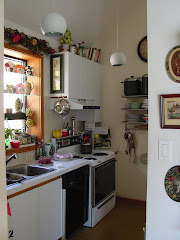






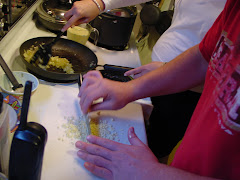




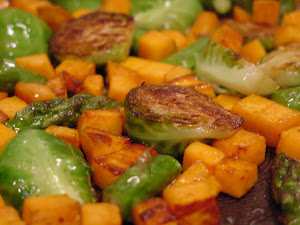.jpg)


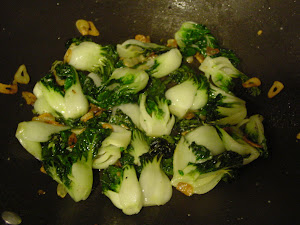
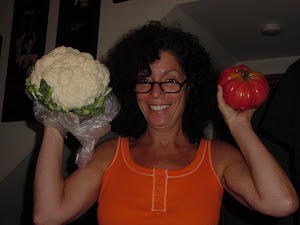
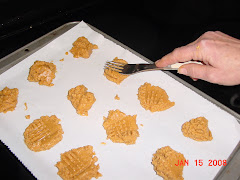.jpg)

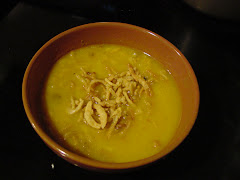

No comments:
Post a Comment